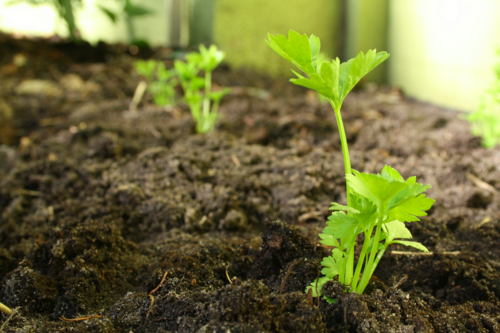
Celery (Apium graveolens) is a common garden vegetable. It forms various stalks with leaves at the top, both of which are edible. In order to be crisp and succulent, this vegetable must be grown quickly.
Description[edit | edit source]
Celery grows with various upright stalks with leaves at the top of each stalk.
The celery flowers are small, white to cream in colour and form in compound bunches.
Growing celery[edit | edit source]
Plant in the springtime. Celery grows best in cool to mild climate zones. If growing in a warmer area, plant in the late summer or autumn (fall).
Choose a position with plentiful sun and lots of warmth. It prefers a loam soil. The soil must drain well.
Prepare the soil. Dig in well rotted compost or manure. One month prior to planting celery, apply lime to the soil.
If sowing seeds, sow into trays, punnets or containers and transplant the seedlings to the garden bed or larger containers.
Add a quality fertiliser to the soil both when planting and during growth. Seaweed tea is a good fertiliser to use on the celery leaves and roots as the plant grows.
Ensure plentiful watering but avoid waterlogging the soil. The roots are shallow and must be well watered during the warmer months.
Blanching the celery[edit | edit source]
Blanching makes the celery stems sweeter, reducing bitterness that would naturally occur if the celery continues to grow in direct light.
Some celery varieties are self-blanching. For these varieties, there is no need to blanch, just harvest when ready from late summer to autumn (fall).
For other varieties, wrap each plant in a cardboard tube from the time that the stems have grown with vigour until the time of harvesting them.
Problems[edit | edit source]
Pests that can bother celery include aphids. Keep the plant well watered in dry weather.
Disease problems include septoria leaf spot. This is most likely to occur in cool weather. To reduce the likelihood, choose disease-free seed and rotate the crop.
If the celery bolts, attempting to seed early, this is often a sign that it has been cold suddenly, then warms up again. This can be a particular problem for hill and maritime climate zones. It may also bolt if the soil dries out too much, reinforcing the importance of ensuring sufficient watering.
If the stalks are thin and dry, this indicates either a lack of sufficient moisture or a lack of fertiliser (or both). If the stalks split, this usually means that the soil was too dry but it may also indicate an excess of nitrogen. Water regularly and ensure that the plant gets balanced fertiliser, such as liquid seaweed tea.
Uses for celery[edit | edit source]
Celery is a useful culinary vegetable. It can be added to soups, stir-fries, salads, stews, pasta sauces, vegetable bakes, and more. It can also be used in juices.